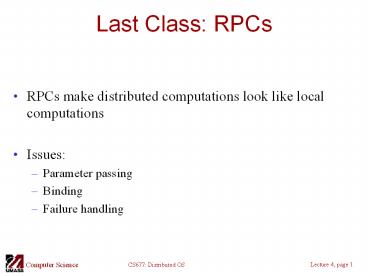Last Class: RPCs - PowerPoint PPT Presentation
Title:
Last Class: RPCs
Description:
... stub calls svc_register to register prog. #, version # with local ... map of client to server address space ... implicit binding using only global references ... – PowerPoint PPT presentation
Number of Views:12
Avg rating:3.0/5.0
Title: Last Class: RPCs
1
Last Class RPCs
- RPCs make distributed computations look like
local computations - Issues
- Parameter passing
- Binding
- Failure handling
2
Today
- Case Study Sun RPC
- Lightweight RPCs
- Remote Method Invocation (RMI)
- Design issues
3
Case Study SUNRPC
- One of the most widely used RPC systems
- Developed for use with NFS
- Built on top of UDP or TCP
- TCP stream is divided into records
- UDP max packet size lt 8912 bytes
- UDP timeout plus limited number of
retransmissions - TCP return error if connection is terminated by
server - Multiple arguments marshaled into a single
structure - At-least-once semantics if reply received,
at-least-zero semantics if no reply. With UDP
tries at-most-once - Use SUNs eXternal Data Representation (XDR)
- Big endian order for 32 bit integers, handle
arbitrarily large data structures
4
Binder Port Mapper
- Server start-up create port
- Server stub calls svc_register to register prog.
, version with local port mapper - Port mapper stores prog , version , and port
- Client start-up call clnt_create to locate
server port - Upon return, client can call procedures at the
server
5
Rpcgen generating stubs
- Q_xdr.c do XDR conversion
- Detailed example later in this course
6
Lightweight RPCs
- Many RPCs occur between client and server on same
machine - Need to optimize RPCs for this special case gt
use a lightweight RPC mechanism (LRPC) - Server S exports interface to remote procedures
- Client C on same machine imports interface
- OS kernel creates data structures including an
argument stack shared between S and C
7
Lightweight RPCs
- RPC execution
- Push arguments onto stack
- Trap to kernel
- Kernel changes mem map of client to server
address space - Client thread executes procedure (OS upcall)
- Thread traps to kernel upon completion
- Kernel changes the address space back and returns
control to client - Called doors in Solaris
8
Doors
- Which RPC to use? - run-time bit allows stub to
choose between LRPC and RPC
9
Other RPC Models
- Asynchronous RPC
- Request-reply behavior often not needed
- Server can reply as soon as request is received
and execute procedure later - Deferred-synchronous RPC
- Use two asynchronous RPCs
- Client needs a reply but cant wait for it
server sends reply via another asynchronous RPC - One-way RPC
- Client does not even wait for an ACK from the
server - Limitation reliability not guaranteed (Client
does not know if procedure was executed by the
server).
10
Asynchronous RPC
2-12
- The interconnection between client and server in
a traditional RPC - The interaction using asynchronous RPC
11
Deferred Synchronous RPC
- A client and server interacting through two
asynchronous RPCs
2-13
12
Remote Method Invocation (RMI)
- RPCs applied to objects, i.e., instances of a
class - Class object-oriented abstraction module with
data and operations - Separation between interface and implementation
- Interface resides on one machine, implementation
on another - RMIs support system-wide object references
- Parameters can be object references
13
Distributed Objects
- When a client binds to a distributed object, load
the interface (proxy) into client address space - Proxy analogous to stubs
- Server stub is referred to as a skeleton
14
Proxies and Skeletons
- Proxy client stub
- Maintains server ID, endpoint, object ID
- Sets up and tears down connection with the server
- Java does serialization of local object
parameters - In practice, can be downloaded/constructed on the
fly (why cant this be done for RPCs in general?) - Skeleton server stub
- Does deserialization and passes parameters to
server and sends result to proxy
15
Binding a Client to an Object
Distr_object obj_ref //Declare a systemwide
object referenceobj_ref // Initialize the
reference to a distributed objectobj_ref-gt
do_something() // Implicitly bind and invoke a
method (a) Distr_object objPref //Declare a
systemwide object referenceLocal_object
obj_ptr //Declare a pointer to local
objectsobj_ref //Initialize the reference
to a distributed objectobj_ptr
bind(obj_ref) //Explicitly bind and obtain a
pointer to the local proxyobj_ptr -gt
do_something() //Invoke a method on the local
proxy (b)
- (a) Example with implicit binding using only
global references - (b) Example with explicit binding using global
and local references
16
Parameter Passing
- Less restrictive than RPCs.
- Supports system-wide object references
- Java pass local objects by value, pass remote
objects by reference
17
DCE Distributed-Object Model
- Distributed dynamic objects in DCE.
- Distributed named objects
18
Java RMI
- Server
- Defines interface and implements interface
methods - Server program
- Creates server object and registers object with
remote object registry - Client
- Looks up server in remote object registry
- Uses normal method call syntax for remote methods
- Java tools
- Rmiregistry server-side name server
- Rmic uses server interface to create client and
server stubs
19
Java RMI and Synchronization
- Java supports Monitors synchronized objects
- Serializes accesses to objects
- How does this work for remote objects?
- Options block at the client or the server
- Block at server
- Can synchronize across multiple proxies
- Problem what if the client crashes while
blocked? - Block at proxy
- Need to synchronize clients at different machines
- Explicit distributed locking necessary
- Java uses proxies for blocking
- No protection for simultaneous access from
different clients - Applications need to implement distributed
locking































